At Kayne Griffin Corcoran, artists place the architecture of art in the frame
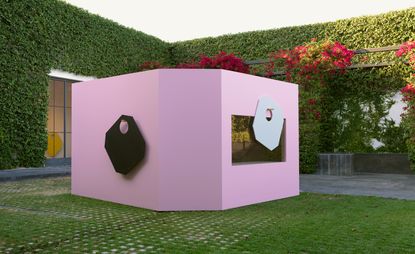
There is an inherent dialogue in the pairing of Jean-Pascal Flavien and Mika Tajima at Los Angeles gallery Kayne Griffin Corcoran, one that explores how our physical environments probe our emotional and social states, and vice versa. It is easy to think of architecture as fixed and permanent, but their works prove that the spaces we inhabit can be flexible and can afford their human participants a surprising amount of agency.
Flavien’s Statement House, as erected in the gallery’s courtyard, is a beautiful blush pink, its interior illuminated by a round skylight. But physical attributes do not describe this house, rather, its inherent mutability does. By inviting two screenwriters, David L Brundige and Max Kopelowicz, to man a Twitter feed that serves as an ongoing 'script' for the house, Flavien explores the possibilities of language, humour and spontaneity in conjuring architecture and daily domestic life. A quick look at Flavien’s Instagram feed reveals his own ongoing observations of the house’s contingencies, including the shifting pool of sunlight at different times of day, to various guests that inhabit the house, to plans for the house that sometimes do, and sometimes do not, actually happen.
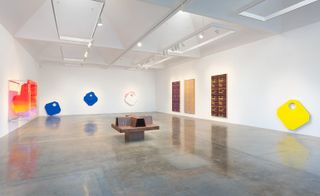
Installation view.
Tajima’s works are more specifically concerned with social spaces, particularly as shaped by labour and technology. Hanging on the wall inside the gallery is a work from the 'Epimelesthai Sautou (Take Care)' series, a cast acrylic form comprising a hot tub with four seats, spray-painted in bright red, yellow and purple. Directly in front of it is a sculpture that could be its inverse: a bench designed after Herman Miller’s 2013 Public Office Landscape furniture system, however, its seats are facing away from each other in an apparent conflict of workplace harmony.
The fixed configurations of the two sculptures provoke thinking on what it means to design for optimisation – for example, do we seek efficiency only to sacrifice flexibility? This question, as it pertains to cities, and to our increasingly vast digital spaces, is explored in Tajima’s Meridian, a light installation connected to a program that analyses the Twitter feeds of the citizens of New Songdo City, Korea, a master-planned city emphasising sustainability and hi-tech living. Tweets are analysed for positive and negative feelings, with the colour and intensity of the lights fluctuating in real time according to the aggregate sentiment. The artist notes: 'The installation underlines the entanglement of our embodied senses with a global network system that seeks to maximise "quality of life" through computational means. The pursuit of quality of life is at the expense of different possible ways of life.'
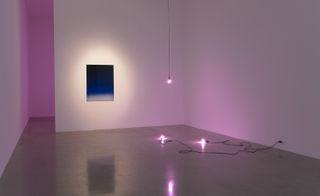
'Meridian', by Mika Tajima, 2016
Perhaps, then, the most possibility arises from thinking abstractly. On the wall amid the Meridian installation is Tajima’s Furniture Series, which is not of furniture at all but rather abstract compositions of spray enamel on flat acrylic panels, as if they were transcendent analogues to a desk or a chair. Her Negative Entropy textiles are more specific: the colorful, abstract weavings are visually based on industrial sounds, and represent individual laborers in different workplaces. Nearby, alternate floor plans for Flavien’s house, in different colours and with slight variations, hang cheerily on the wall, arguing that all you might need to do, if met with a challenging space, is to change the plan.
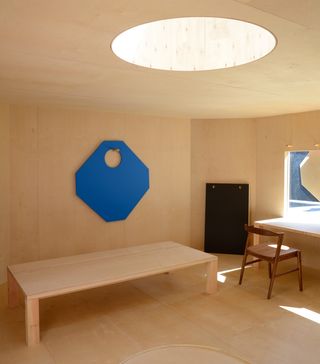
A view inside Flavien's statement house (temporary title) Los Angeles, 2016.

Epimelesthai Sautou (Take Care), 1, by Mika Tajima, 2014.
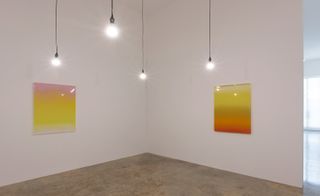
Installation view of Furniture Art (Socorro Island), by Mika Tajima, 2016.

Social Chair, by Mika Tajima, 2016.
INFORMATION
The exhibition runs until 29 October. For more information, visit the Kayne Griffin Corcoran website
ADDRESS
1201 S La Brea Ave
Los Angeles
CA 90019
Wallpaper* Newsletter
Receive our daily digest of inspiration, escapism and design stories from around the world direct to your inbox
-
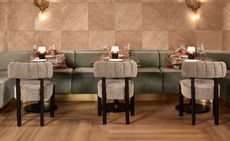 Famed steakhouse Beefbar opens an art deco-infused outpost in New York City
Famed steakhouse Beefbar opens an art deco-infused outpost in New York CityBeefbar’s first US location finds a home in an impressive 1920s Tribeca building, boasting interiors by Humbert & Poyet
By Dan Howarth Published
-
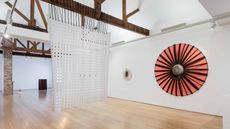 John Cage’s ‘now moments’ inspire Lismore Castle Arts’ group show
John Cage’s ‘now moments’ inspire Lismore Castle Arts’ group showLismore Castle Arts’ ‘Each now, is the time, the space’ takes its title from John Cage, and sees four artists embrace the moment through sculpture and found objects
By Amah-Rose Abrams Published
-
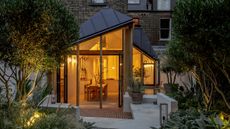 Architects collaborate on geometric extension to radically re-shape a London house
Architects collaborate on geometric extension to radically re-shape a London houseMediterranean influences, earthy tones and quirky angles abound in this geometric extension and the soaring living spaces of this reconfigured Victorian townhouse
By Jonathan Bell Published
-
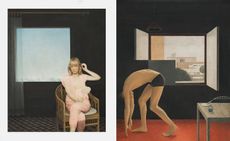 Surreal, uncanny, seductive: step into Graham Little’s world
Surreal, uncanny, seductive: step into Graham Little’s worldScottish artist Graham Little presents his first US retrospective at The FLAG Art Foundation in New York
By Hannah Silver Published
-
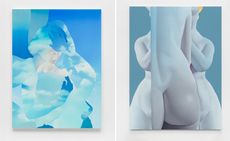 The cosmos meets art history in Vivian Greven’s New York exhibition
The cosmos meets art history in Vivian Greven’s New York exhibitionVivian Greven’s ‘When the Sun Hits the Moon’, at Perrotin in New York City, is the artist’s first solo exhibition in the USA
By Emily McDermott Published
-
 Detroit Institute of Arts celebrates Black cinema
Detroit Institute of Arts celebrates Black cinema‘Regeneration: Black Cinema 1898-1971’ at the Detroit Institute of Arts (DIA) brings lost or forgotten films, filmmakers and performers to a contemporary audience
By Anne Soward Published
-
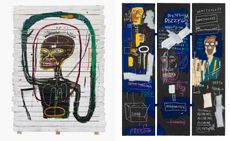 Jean-Michel Basquiat’s LA-made work goes on show at Gagosian
Jean-Michel Basquiat’s LA-made work goes on show at Gagosian‘Made on Market Street’ at Gagosian in Beverly Hills is the first show to present works made by the young artist between 1982 and 1984
By Hunter Drohojowska-Philp Published
-
 BLUM marks 30 years of Japanese contemporary art in America
BLUM marks 30 years of Japanese contemporary art in AmericaBLUM will take ‘Thirty Years: Written with a Splash of Blood’ to its New York space in September 2024, continuing its celebration of Japanese contemporary art in America
By Timothy Anscombe-Bell Published
-
 Todd Gray’s sculptural photography collages defy dimension, linearity and narrative
Todd Gray’s sculptural photography collages defy dimension, linearity and narrativeIn Todd Gray’s New York exhibition, he revisits his 40-year archive, fragmented into elaborated frames that open doors for new readings
By Osman Can Yerebakan Published
-
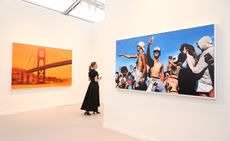 Frieze LA 2024 guide: the art, gossip and buzz
Frieze LA 2024 guide: the art, gossip and buzzOur Frieze LA 2024 guide includes everything you need to know and see in and around the fair
By Renée Reizman Published
-
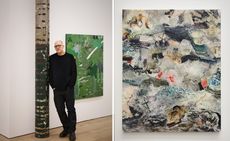 New York artist Christopher Astley showcases an alternative natural world
New York artist Christopher Astley showcases an alternative natural worldAt Martos Gallery in New York, Christopher Astley’s paintings evoke an alternative natural world and the chaos of warfare (until 16 March 2024)
By Tianna Williams Published